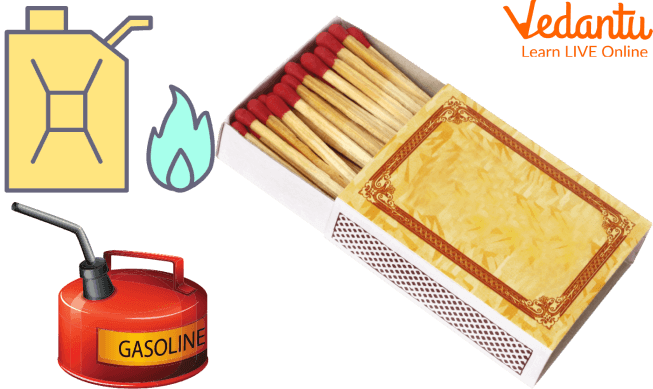




What are Combustible Materials?
A combustible material is something that can be easily ignited and burned. When exposed to fire or heat, a combustible material will ignite, burn, sustain combustion, or emit flammable gases in the form which is utilised under certain conditions. Combustible materials include wood, paper, rubber, and plastics.
Here we will discuss flammable vs inflammable materials. You will get a quick overview of flammable and inflammable materials, how to identify combustible materials, and the importance of these materials.
Flammable Materials
Flammable materials are those that catch fire readily. Some examples like matches and lighters are flammable material.

Flammable Materials
Risks of Flammable Materials
Indeed, even tiny amounts of combustible fluid fumes might light up and cause serious injury and harm, particularly when the vapours gather in inadequately ventilated rooms or shut holders, they might explode. Critically, changes in temperature and pressure can influence the properties of combustible or flammable substances. One litre of combustible fluid- when completely vanished, may create 5,000 litres of a hazardous fume/air blend, enough to fill up a little store room or carport.
Inflammable Materials
Inflammable substances are those substances that burst into flames effectively, and their ignition temperature is extremely low. Instances of inflammable substances are liquor, petroleum, melted oil gas, etc. Inflammable is a French word that signifies "to burn down". Inflammable substances are otherwise called burnable or combustible substances. Inflammable substances are exceptionally directed and are extremely perilous.
Properties of Inflammable Substances
Inflammable substances have extremely low flash points.
They are exceptionally vulnerable to flames.
Inflammable substances have higher fume strain because of which flash point diminishes and combustibility increment in inflammable substances are exceptionally flammable.
The main example of an inflammable substance is coal which is by, and large found as sedimentary rocks and is essentially utilised in creating intensity and light. It is a natural compound that comprises carbon and hydrogen bonds.
Examples of inflammable substances are acetones, firecrackers, benzene, propane, zinc powder, blowtorch, butane, condensed oil gas, petroleum, magnesium, lamp oil, etc. Inflammable substances are unsafe in various circumstances as bunches of materials are combustible and burst into fire. Safety precautions are necessary while using these things.

Inflammable Materials
Flammable Vs. Inflammable Materials
Here we will discuss the differences between flammable and inflammable materials to clear this out.
Summary
The degree of flammability or combustibility in air depends largely upon the volatility of the material, this is related to its composition-specific vapour pressure, which is temperature-dependent. The quantity of vapour produced can be enhanced by increasing the surface area of the material, forming a mist or dust.
Here, we learned about inflammable materials, flammable materials, and which materials are flammable. Flammable materials are those materials that catch fire easily. Some examples include coal, kerosene, etc. Inflammable materials are those which do not catch fire easily. Some examples are glass, water, etc. Flammable vapours are emitted by flammable materials.
FAQs on Which Materials are Flammable?
1. What makes a material flammable?
A material is considered flammable if it has a very low ignition temperature, meaning it can catch fire and burn easily when exposed to a source of heat or a spark. These substances release flammable vapours at or below normal room temperature, which can ignite quickly.
2. What are five common examples of flammable materials?
Five common examples of flammable materials found in daily life include:
- Petrol and Diesel (liquids)
- LPG (Liquefied Petroleum Gas) and CNG (Compressed Natural Gas) (gases)
- Alcohol and Acetone (solvents)
- Wood and Paper (solids)
- Cotton and certain synthetic fabrics (solids)
3. What is the difference between flammable and combustible materials?
The main difference lies in their ignition temperature or flash point. Flammable materials can ignite at normal working temperatures (typically below 37.8°C). Combustible materials require higher temperatures to ignite (typically above 37.8°C). For example, petrol is flammable, while diesel fuel and wood are considered combustible.
4. Are 'flammable' and 'inflammable' the same thing?
Yes, 'flammable' and 'inflammable' mean the exact same thing: a substance that burns easily. This is a common point of confusion. The prefix 'in-' in 'inflammable' comes from the Latin verb 'inflammare,' which means 'to cause to catch fire,' not 'non-flammable'. To avoid accidents, safety organisations now prefer using only the term flammable for materials that burn and non-flammable for those that do not.
5. How are flammable materials classified?
Flammable materials are generally classified by their physical state into three main types:
- Flammable Solids: Materials like wood, paper, certain plastics, and magnesium metal that can be easily ignited.
- Flammable Liquids: This common category includes substances like petrol, kerosene, ethanol, and acetone, which produce dangerous flammable vapours.
- Flammable Gases: These include hydrogen, propane, butane, and acetylene, which can form explosive mixtures with air.
6. Why is it important to know a material's flammability, especially at home?
Knowing a material's flammability is crucial for safety and accident prevention. Many household products like deodorants, hand sanitisers, cooking oils, and cleaning agents are flammable. This knowledge helps in:
- Proper Storage: Keeping them away from heat sources like stoves, sparks, or direct sunlight.
- Safe Usage: Ensuring good ventilation when using products that release flammable vapours.
- Fire Safety: Understanding what could fuel a fire helps in preventing it and reacting correctly if one starts.
7. What are some examples of non-flammable materials?
Non-flammable materials are substances that do not ignite or burn when exposed to fire under normal conditions. Common examples include:
- Water
- Stone and Concrete
- Glass
- Most metals like iron and steel
- Inert gases like Helium, Neon, and Nitrogen
8. How does temperature affect the flammability of a substance?
Temperature directly impacts a substance's flammability. As the temperature of a flammable liquid rises, it evaporates more quickly, releasing a higher concentration of flammable vapours. This increases the risk of ignition. The lowest temperature at which a liquid produces enough vapour to form an ignitable mixture with air is its flash point. A substance with a lower flash point is considered more flammable and hazardous.









